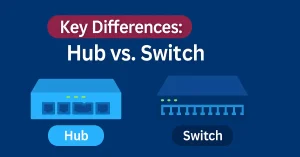Routing is the process of selecting paths in a network along which to send network traffic. It forms the backbone of all data communication in IP networks, enabling devices to exchange data across different networks. Routers, the critical devices in this process, forward packets based on the destination IP address, learning about remote networks through two primary methods: static routing and dynamic routing protocols. This comprehensive guide, tailored for CCNA and CCNP students, explores these methods in depth, including configurations, advantages, disadvantages, real-world use cases, and exam preparation tips to help you excel in Cisco certifications.
What is Static Routing?
Static routing involves manually configuring routes in a router’s routing table by the network administrator. Unlike dynamic protocols, static routes do not adapt to network changes automatically and require manual updates, making them a deliberate choice for specific scenarios.
Example:-
Router(config)# ip route 192.168.2.0 255.255.255.0 192.168.1.2
This command adds a static route to the 192.168.2.0/24 network via the next-hop address 192.168.1.2.
When to Use Static Routing
- Small Networks or Stub Networks: Ideal for setups with a single exit path, such as branch offices.
- High-Security Environments: No route advertisements reduce exposure to threats.
- Predictable Traffic: Suited for management interfaces or known paths, e.g., in CCNA labs.
What is Dynamic Routing?
Dynamic routing protocols enable routers to automatically discover and maintain routes to remote networks. These protocols, such as RIP, OSPF, EIGRP, and BGP, exchange routing information with neighboring devices and adapt to topology changes through a process called convergence.
Key Dynamic Protocols (Expanded for CCNP)
Dynamic protocols are classified as distance-vector (e.g., RIP, EIGRP) or link-state (e.g., OSPF). Here’s a deeper dive:
- RIP (Routing Information Protocol): A simple distance-vector protocol using hop count as the metric (max 15 hops). Suitable for small networks but outdated for modern enterprises due to slow convergence. In CCNA, focus on RIPv2 for classless routing support.
- OSPF (Open Shortest Path First): A link-state protocol using Dijkstra’s Shortest Path First (SPF) algorithm to build a topology map. It supports areas for hierarchy, fast convergence, and equal-cost load balancing. OSPF is ideal for multi-vendor environments as an open standard. Key features include Link-State Advertisements (LSAs), Designated Routers (DRs) for multi-access networks, and support for IPv6 via OSPFv3.
- EIGRP (Enhanced Interior Gateway Routing Protocol): A Cisco-proprietary hybrid protocol (distance-vector with link-state elements) using the Diffusing Update Algorithm (DUAL) for loop-free paths and feasible successors. It excels in rapid convergence and unequal-cost load balancing. EIGRP supports summarization at any point and is efficient in Cisco-only shops.
- BGP (Border Gateway Protocol): A path-vector protocol for inter-AS routing, focusing on policy-based decisions rather than metrics. For CCNP, understand iBGP vs. eBGP and attributes like AS-Path.
No manual reconfiguration is needed for topology changes, though initial setup is essential. In 2025, dynamic protocols like OSPF and EIGRP emphasize integration with SD-WAN and cloud-native environments in the CCNA syllabus. manual reconfiguration is needed for topology changes, though initial setup is essential.
Using Static and Dynamic Routing Together
Routers can combine static and dynamic routing for flexibility. Static routes, with an Administrative Distance (AD) of 1, take precedence over dynamic routes (e.g., OSPF AD=110). Common use cases include:
- Floating Static Routes: Backup routes with a higher AD (e.g., 200) to activate if dynamic routes fail.
- Default Routes: Static defaults for internet access, e.g., ip route 0.0.0.0 0.0.0.0.
Example:-
Router(config)# ip route 10.0.0.0 255.0.0.0 172.16.1.1 200 // Floating static with AD=200
When to Use Each
- Static Routing: Best for small networks, stub areas, or high-security zones. Perfect for CCNA labs with predictable paths. Use in 2025 for simple SD-WAN edges.
- Dynamic Routing: Suited for large, dynamic networks. Use OSPF or EIGRP for enterprise environments (CCNP focus). OSPF for multi-vendor; EIGRP for Cisco speed.
- Suggestion: Include a network topology diagram here showing stub vs. core networks for visual learning.
Comparison Table
| Aspect | Static Routing | Dynamic Routing |
|---|---|---|
| Configuration | Manual | Automatic via protocols |
| Scalability | Low (small networks) | High (large networks) |
| Overhead | Low CPU and bandwidth usage | Higher due to route updates |
| Adaptability | None | High (convergence) |
| Security | High (no advertisements) | Lower (advertises routes) |
Administrative Distance (AD)
Administrative Distance (AD) determines route preference, with lower values preferred:
- Connected: 0
- Static: 1
- EIGRP (internal): 90
- OSPF: 110
- RIP: 120
- External BGP: 200
For CCNP, use show ip route to verify active routes and adjust AD with ip route … distance if conflicts arise.
Advantages and Disadvantages
Advantages of Static Routing
- Enhanced Security: No route advertisements prevent exposure to attacks like route hijacking.
- Low Resource Use: Minimal bandwidth and CPU cycles, ideal for resource-constrained devices.
- Predictable Paths: Ensures consistent traffic flow over known routes.
Disadvantages of Static Routing
- Manual Maintenance: Requires significant time and expertise for updates.
- No Fault Tolerance: Manual intervention is needed for network failures.
- Complexity Growth: Risk of misconfiguration increases in large networks.
Advantages of Dynamic Routing
- Easy Setup: Quick configuration and maintenance with automated updates.
- Automatic Adaptation: Adjusts to topology changes without manual input.
- Scalability: Handles network growth efficiently.
Disadvantages of Dynamic Routing
- Security Risk: Route advertisements can be exploited (mitigate with MD5 authentication).
- Bandwidth Use: Continuous handshakes increase overhead.
- Unknown Paths: Less predictable routing decisions may affect performance.
Expansions for CCNP
Troubleshooting
- Commands: Use show ip route to view the routing table, ping or traceroute to test connectivity.
- Debugging: Enable debug ip routing cautiously for real-time updates.
- Common Issues: Check AD conflicts or misconfigured next-hops.
IPv6 Considerations
- Static: Configure with IPv6 route 2001:db8::/32 2001:db8:1::1.
- Dynamic: Use OSPFv3 or EIGRP for IPv6 routing.
Security Enhancements
- Enable MD5 authentication in OSPF: ip ospf authentication message-digest.
- Apply Access Control Lists (ACLs) to filter route updates.
Case Studies
- Small Office: A 10-user network uses static routes for a single internet link, saving resources.
- Enterprise: A 500-user campus deploys OSPF with static defaults for redundancy.
Conclusion
For CCNA students, master static routing basics and simple dynamic setups (e.g., RIP) to build a strong foundation. For CCNP, delve into advanced protocols like OSPF, EIGRP, and BGP, optimizing with AD adjustments and security measures. This guide equips you with practical knowledge for Cisco exams and real-world network design. Practice with tools like Packet Tracer or GNS3 to reinforce concepts. Stay updated with evolving protocols and security practices as of August 2025.





